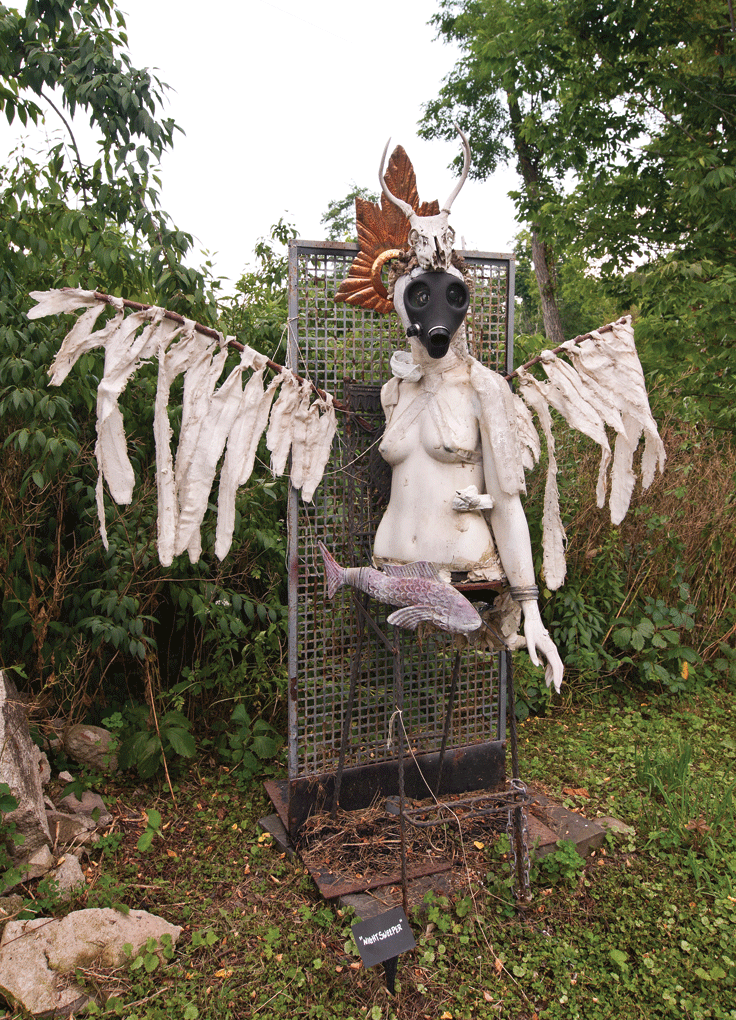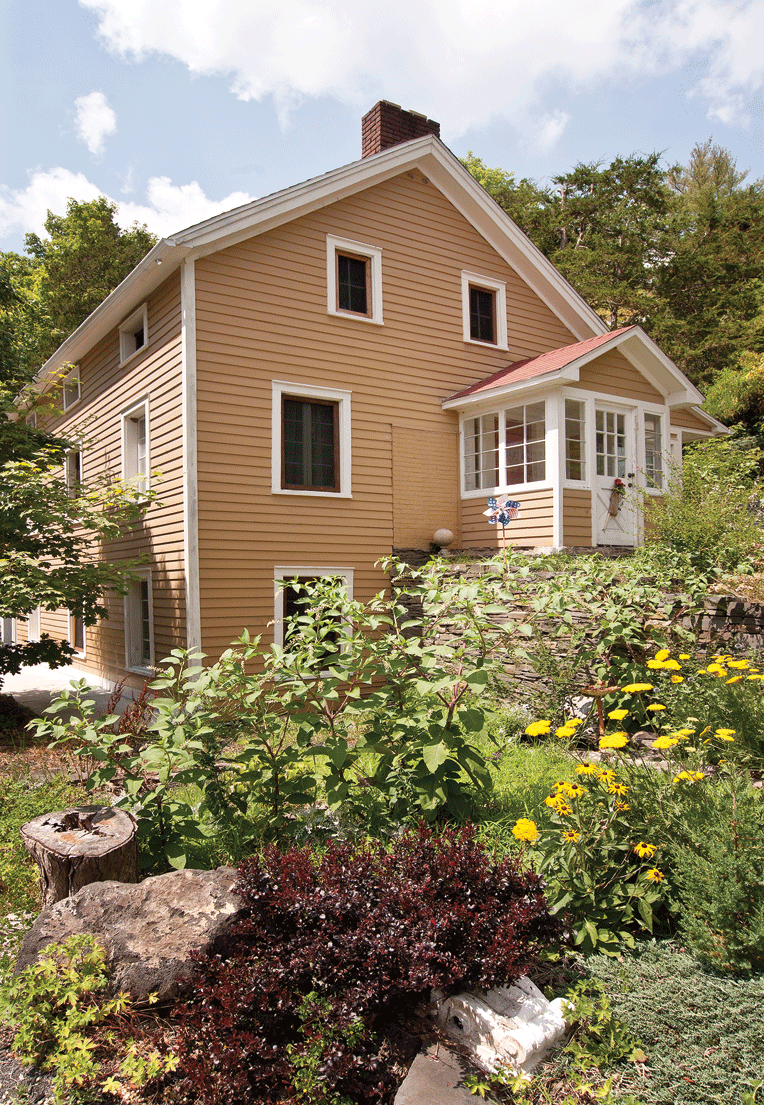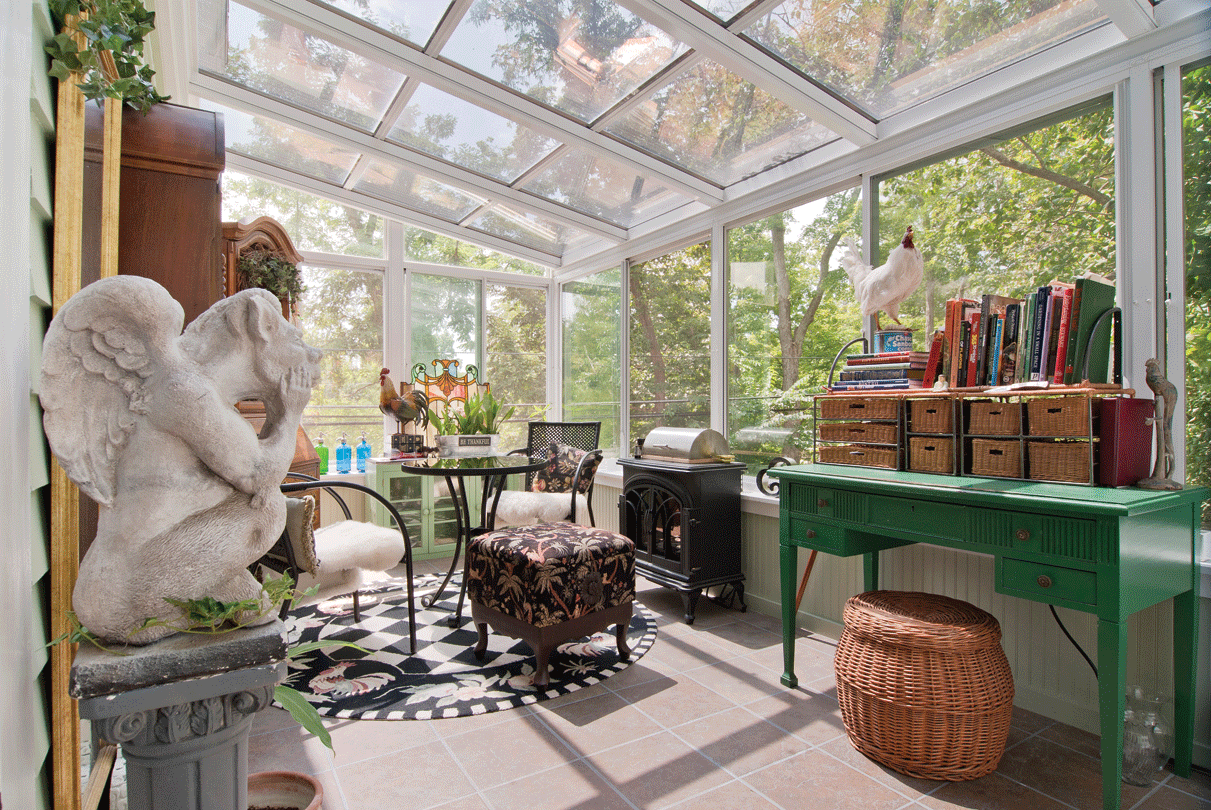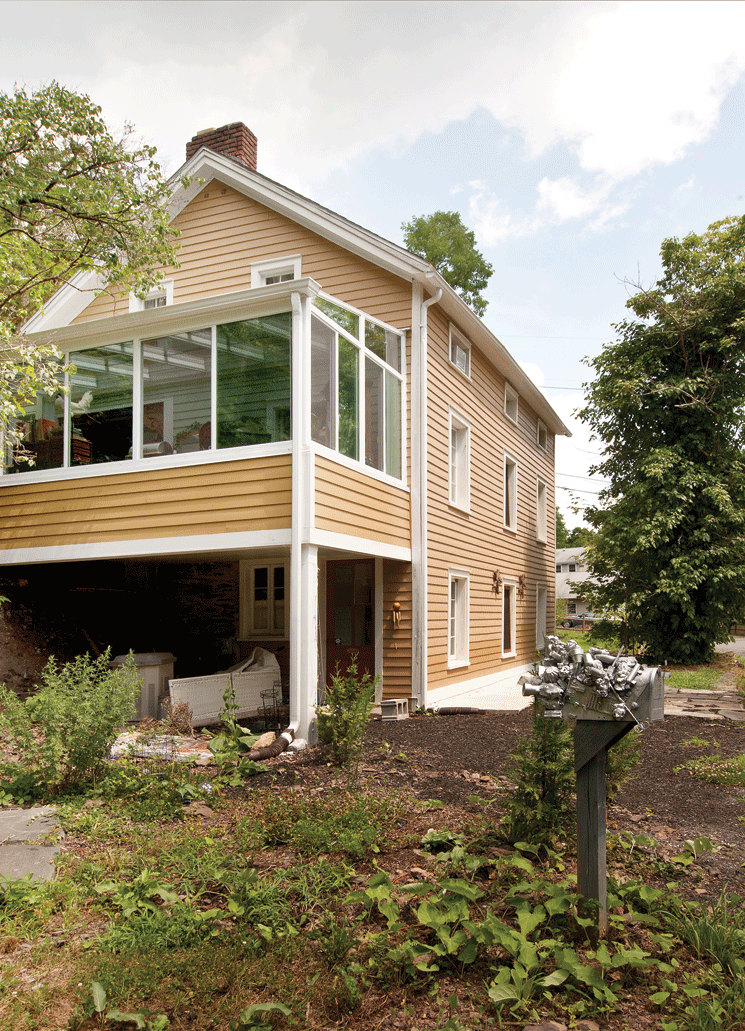Artist Jacquie Roland thought she’d “screwed the pooch” when she badly broke her left knee and right foot two years after buying a ramshackle 1795 Saugerties three-story. After the accident the childless widow hit personal bottom. “I was in a nursing home for seven months,” says Roland. “Money was tight, and all I could think of was, ‘Now what am I going to do?’ living alone in that work-in-progress house, with just an open toilet on the middle floor.”
Roland’s house is built into a rocky hillside on one of Saugerties’ oldest roads. The front entrance and current kitchen are on the second floor. The house is an exact copy of a Brooklyn farmhouse. There’s a little stream and scenic waterfall off the bluestone patio. With beamed ceilings and wide-plank floors, it’s drenched with authentic period charm.
Roland’s brother, Jim, came up from Baltimore to help care for his sister. A bohemian known for her sense of humor, Roland thought she could barter housing to mitigate the immediate costs of altering the house for someone who could barely walk. A carpenter acquaintance moved in downstairs. She had to ask him to leave when he didn’t get much done and seemed intent on living in her house rent-free forever.
A fellow artist suggested she hire Peter Osterhoudt, a contractor who descends from one of Saugerties’ founding families, but he was busy with another job, so he hooked Roland up with Denis Argueta, owner of Alcon Construction in Glasco. That was Roland’s lucky break. Thanks to the caring nature and professional integrity of Argueta’s team, who will soon make Roland’s house wheelchair accessible, the artist now expects to live in her house for the rest of her life. “Although I can today use the stairs again, I can also live completely on the middle floor, where there’s a daybed in the living room,” says Roland. “Later, if necessary, I can have a caregiver on the bottom floor—it has a full bath. But I’m using that space as an art studio right now because it’s really the best part of this house.”
Five years after the accident, Roland’s finally accepted the tough reality that she’s no longer able to drive—she relies on friends, taxis, and mail-order to get by. This June, she finally gave the Saab 955 Turbo she’d bought new two months before the accident to her brother as a thank you gift.
Roland says that although she’s now effectively housebound, she still leads a very full life, courtesy of the many friends she’s made in the Hudson Valley since retiring to the area in 1987, at age 47, with a comfortable government pension. This August marks her 10th year as a participant on the Saugerties Artists Studio Tour. A painting of Roland’s plays a key role in the 2007 thriller The Life Before Her Eyes starring Uma Thurman. Last October her paintings were exhibited in a solo show at the Storefront Gallery in Kingston. A frequent winner of highly competitive greeting card contests—more prestigious than lucrative—Roland recently sold Hallmark a poem and an essay for a forthcoming book, Thanks Mom.

“Nightsweeper,” created in 2009, is inspired by a food-gathering character inFrank Herbert’s novel “Hellstrom’s Hive.”
Downsizing from a mansion to a tea room
Roland bought the former Wales Tea Room, once an important warming-up stop on the road to Woodstock from Saugerties’ Exchange Hotel, in 2004 for $220,000. Ready to downsize, she had purchased the Forst Mansion on Abeel Street in Kingston’s Rondout area for $150,000 in the 1980s. Though she describes it as “a 10-room money pit,” Roland nevertheless realized a tidy profit by selling into the real estate boom. Fresh out of a long-term relationship, she wanted a new start.
Like the period mansion Roland was selling, the Wales Tea Room had loads of interesting features (including an 18th-century beehive oven), augmented by moody spaces in which to both make and display art. Partially renovated by some “shady real estate speculators” who had bought the falling-down historic site in 2002 for $30,000, it still needed “a tremendous amount of work,” says Roland. Abandoned for 40 years, it had structural problems. But the would-be house flippers had run out of money, and didn’t bother to attend the sales closing.
The first thing Roland did was install a generator. Then she began to work on the house decoratively, while also making art for local and regional shows. She wrote a couple of children’s books, one entirely in palindromes. Single, energetic, and mobile, Roland didn’t care much initially about the cramped, outdated kitchen. The house was comfortable enough, with three bedrooms and two full baths. Building a “powder room” around the middle floor’s peculiar open-air toilet simply wasn’t a priority. All that changed with a fall in a local cinema.
After the Fall
Initially, Roland’s friends rallied around her. But as time passed, she realized she’d become a burden. Finding a new romantic partner seemed out, because “Let’s face it, most of the men in my age bracket are looking for someone to take care of them,” says Roland. She thought seriously about moving back to Baltimore, where she’d spent most of her life and had the strongest support group. And that’s what she would have done if her home-renovation plan bombed and her health failed further.
“For four years after the accident, I lived with severe seasonal affective disorder, too,” says Roland. “There wasn’t a single window on the north side of this house—it was built to keep out the cold, of course—but the southern exposure was also dark, because it’s so old, with very small windows.”
While confined post-accident to the middle floor, the artist decided that if she was going to update the kitchen, she’d also add a sunroom. Roland had researched conservatory options for her previous residence. She bought a Four Seasons Sunroom from Hudson Valley Sunrooms in Port Ewen. Although the sunroom could be installed in three days, since it was a second-floor addition, it needed substantial preparatory construction, meticulously executed by Argueta and his crew. The total cost for the addition was about $50,000.
“The sunroom arrived at 2am on a huge truck from Florida, and the owner of Hudson Valley Sunrooms, whose last name is actually Smiley, was here to receive it, which I thought went above and beyond the call of duty,” says Roland. “He stayed for two hours, until all the pieces were unwrapped.”
That was in March 2010. Since then, Roland’s life has become much more enjoyable. Seated comfortably in her sparkling sunroom, surrounded by art and her favorite colors of black and green, Roland looks out on a car driving past slowly. The driver is clearly distracted by her macabre yard sculptures, death angels in gas masks from Roland’s “Welcome to My Nightmare” series.
“My neighbors call me ‘the artist lady,’ and these days, I’m almost always in the sunroom. The renovations took the very last of my Kingston house money, but I’m just so glad I did it,” says Roland. “Also, a magazine feature that’s partly about my flair for decorating was on my bucket list.”















